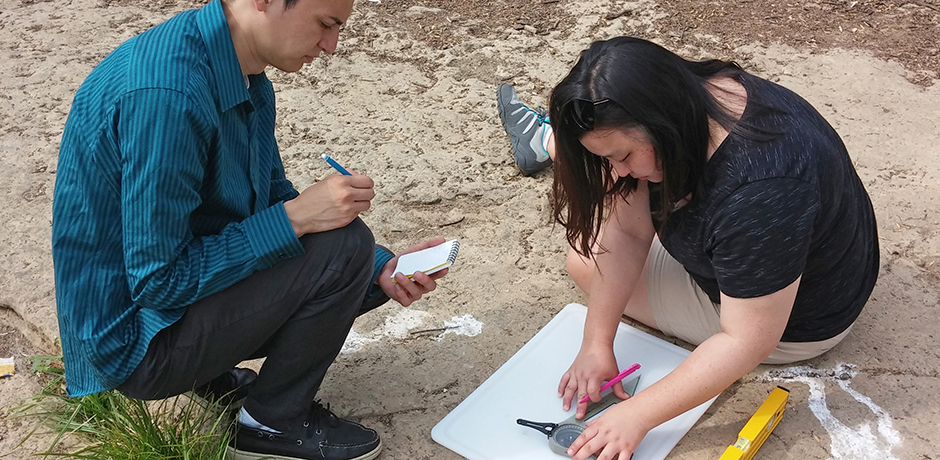A National Science Foundation-sponsored summer undergraduate research grant is enabling future science teachers Michelle Manzano and Hilary Roath to study soil quality at the Copper Basin mine and surrounding area in Ducktown, Tennessee.
Research partners Katherine Kuklewicz and James Milstead examined air quality, conducting fieldwork at the Stones River National Battlefield in Murfreesboro.

MTSU senior Jonathan Flores, left, and Amber Han conduct geology research along the Murfreesboro Greenway System. (MTSU photos by Mark Abolins)
Ten students, including seven from universities outside Tennessee, are participating in MTSU’s nine-week National Science Foundation Geoenvironmental Challenges Research Experience for Undergraduates, or REU, project.
The five groups’ work was part of nearly 50 projects featured July 31 at MTSU’s Summer Research Celebration in the Student Union Ballroom.
The National Science Foundation, or NSF, funds a large number of research opportunities for undergraduate students nationwide through the program.
An REU Site consists of 10 or more undergraduates who work on research projects at a host institution. Each student is associated with a specific project in which he or she works closely with faculty mentors and other students; participants receive stipends and assistance with housing and travel.
“This is the first National Science Foundation Geosciences Directorate REU designed for future Earth science, chemistry and biology teachers,” said Mark Abolins, a professor in MTSU’s Department of Geosciences and project co-leader with Concrete Industry Management chair Heather Brown.
“Future teachers are involved in one of five mentored science research investigations for eight intense weeks,” Abolins added.
The eight-week research part of the experience is preceded by a one-week field trip to Mammoth Cave and Great Smoky Mountains National Parks, Abolins added.
“The project as a whole is impressive insofar as it has involved 30 future science teachers in eight weeks of intensive science research,” he said.

MTSU senior Jonathan Flores, left foreground, and Caroline Pounal, right, are among students dropping dyed water on a sponge to simulate groundwater movement through limestone at Mammoth Cave National Park during theier five-day field trip.
Manzano, 22, who will be a senior geology major at California State University-Fullerton this fall, said she and Roath, a senior earth/space science major at Florida State University in Tallahassee, “went around and collected soil samples near the (Copper Basin) mines and at the elementary and high schools.”
“We were trying to see if there’s a link between the soil and vegetation,” she said.
Roath, 22, a Jackson, New Jersey, resident, wanted to participate last summer but had to take FSU summer classes instead. She said she wants to discover “how it benefits mankind and students, too.”
Kuklewicz, 22, a May graduate in geology and math at Skidmore College in Saratoga Springs, New York, who begins work in the University of Kansas master’s program in September, said it has been an excellent experience.
“Under the guidance of faculty mentors Sing Chong and Beng ‘B.G.’ Ooi, I have developed a research question, traveled to different field sites, collected samples, analyzed the data and written a research paper soon to be published,” said Kuklewicz, who is from Turner Falls, Massachusetts.
Milstead, 22, a Murfreesboro resident and MTSU biology major minoring in chemistry and anticipating a May 2016 graduation, said the project “has been relatively successful regarding the results.”
“The processes we used to conduct our research can be used in the classroom to show students how the scientific method is actually applied in the ‘real world’,” he added.
Sally Millsap of the MTSU MTeach math-science teacher preparation program recommended the program to Milstead.
Other participants include research partners Daniel Deal and Kirsten Salonga, Caroline Pounal and Kyle Schuetrum and Amber Han and Jonathan Flores. Han and Manzano are from the same university, but had never met until coming to MTSU.
In addition to Chong, Ooi, Brown and Abolins, faculty mentors include professors Jeff Walck and Steve Howard from biology and chair Warner Cribb and assistant professor Jeremy Aber from geosciences.
This marks the third and final summer under the current grant, but Abolins said MTSU is applying for a renewal.
Abolins notes that 20 of 30 participants are women. There have been four black students, five Hispanics, three Asians and one Native American.
— Randy Weiler (Randy.Weiler@mtsu.edu)


COMMENTS ARE OFF THIS POST